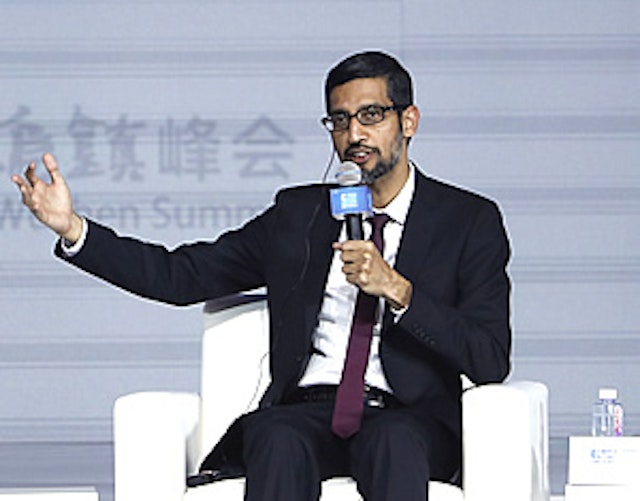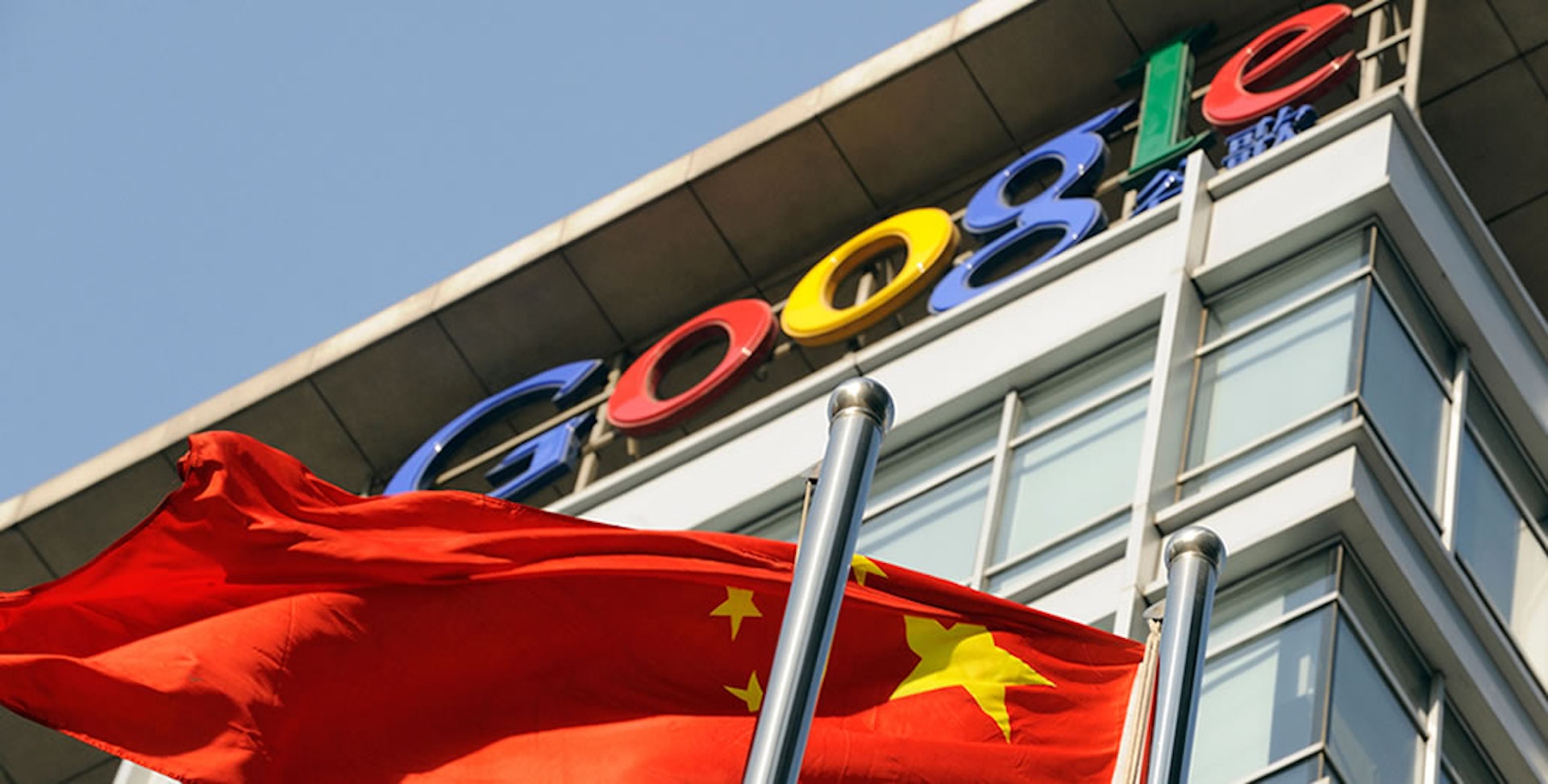Click here to see how TTP identified and tracked Google’s planes »
When Google abruptly pulled the plug on its Chinese search engine in early 2010, the tech giant framed the move as a principled stand against increasing censorship and surveillance in China.
“It was a decision based on values,” then-CEO Eric Schmidt said.
But a new Tech Transparency Project investigation shows the extent to which Google continued to pursue a relationship with China. Through an analysis of FAA flight data, TTP found that planes owned by Google and its top executives have made at least 26 trips to or from mainland China, Hong Kong, and Macau since 2010.
The flight patterns shed light on Google’s intense interest in the Chinese market—and its apparent determination to do business there—despite Beijing’s ongoing crackdown on dissent and the company’s own public misgivings about the Chinese government’s human rights record.
In some cases, multiple Google planes flew to the same Chinese destination at the same time or met in a third country before traveling on to China. The full number of Google flights is likely higher than what TTP identified, because the FAA data for international flights is often incomplete; they also do not include passenger lists or any commercial or charter flights that may have carried company executives.
The earliest known trip to China by a plane belonging to Google executives occurred in March 2008, two years after the company debuted Google.cn, its Chinese search engine. The Boeing 767 that made the flight originally seated 180 people but was reconfigured to seat 50 as part of its remodeling into what Schmidt reportedly called “a party airplane.”
The flight data also suggests that Google executives visited China in the period immediately following the 2010 withdrawal of its search engine, raising questions about whether the company continued to negotiate with the Chinese government on a potential compromise, even as it publicly took a stance against Chinese censorship and cyberattacks.
Google planes made at least three trips to China in late 2010 and 2011, including at least two stops in Beijing. On May 6, 2011, a Boeing 757 belonging to Google principals Larry Page, Sergey Brin, and Eric Schmidt flew from its home base at Moffett Field in Mountain View to Beijing, with a stopover in Anchorage, Alaska. The jet, which carried the tail number N1757, returned to Moffett Field on May 17, 2011, following another stopover in Anchorage.

Sergey Brin, Eric Schmidt, and Larry Page at the Allen & Co. Media summit in Sun Valley, Idaho, in 2010.
Less than six months later, a Gulfstream with the tail number N510QS flew from Moffett Field to Beijing, returning to Moffett on November 4, 2011. The plane is owned by Kavitark Ram Shriram, a founding board member of Google and one of its earliest investors.
The FAA records do not show any Google flights to China for a period of nearly four-and-a-half years, from late 2011 to the spring of 2016. But on March 30, 2016, the Google fleet returned to China, with another Gulfstream flying from San Jose to Beijing with a stop in Seattle. The plane, which is owned by Google, flew back to San Jose from Shenzhen, China, on April 1.
The renewed flight activity appeared to mark the beginning of a new effort to expand Google’s presence in the country. Just two months after the March trip, CEO Sundar Pichai said at a tech conference: “We want to be in China serving Chinese users.”
In fact, the FAA data reveals a notable uptick in recorded flights to China in 2017, when leaked internal documents show Google was beginning to build a new, censored search engine for the Chinese market, codenamed Project Dragonfly. (Google later said it “terminated” the project, after the leaked details sparked a wave of negative publicity.)
China, with its huge population, is an especially attractive market for Google, whose business model relies on accumulating ever more user data and selling it to advertisers. China boasted an estimated 854 million internet users in June 2019, up 26 million over the previous six months.
In early 2017, a Google Gulfstream was in Harbin, a large city in northeast China. The reason for the visit wasn’t clear, though the city is home to the Harbin Institute of Technology, which plays an important role in the country’s missile and space industry.

Sundar Pichai speaks at the World Internet Conference in Wuzhen, Zhejiang, China in December 2017.
A flurry of trips in late 2017, around the time Pichai met with a top Chinese official, was followed by Google’s announcement that it would open an artificial intelligence research center based in Beijing, to work closely with what it called “the vibrant Chinese A.I. research community.” U.S. defense officials have warned that this and other Google partnerships in China could put sensitive American technology in the hands of the Chinese military.
Google has developed at least five corporate partnerships with Chinese firms during the past two years, including its work with Tencent on cloud services and a game it launched for the WeChat app.
Most recently, FAA data shows that Google planes made at least three roundtrip flights to Greater China in 2019. One of them came just days before news reports that Google had suspended much of its business with Huawei, following the Trump administration’s decision to include the Chinese company on a trade blacklist. Google reportedly lobbied against the ban, which restricted Huawei from using licensed versions of the Android operating system for its smartphones.
Despite growing tensions, the company’s cloud efforts in China have continued. In May 2020, Google abandoned its “Isolated Region” initiative, which would have relied on local third parties to control cloud services in China and countries where its operations are politically sensitive. But the company is reportedly still exploring other ways to provide cloud services to Chinese customers.
Timeline of Google’s Activity in China
January 2006: Google debuts its Chinese search engine.
March 2008: A Boeing 767 belonging to Blue City Holdings—a holding company for planes owned by Eric Schmidt and Google co-founders Larry Page and Sergey Brin—flies from San Francisco to Hong Kong on March 12, 2008, with a brief stop in Anchorage, a common refueling point for Google’s flights to and from China. The plane, which uses the tail number N2767, leaves Hong Kong on March 16, 2008, and arrives back in San Francisco after stopping in Honolulu. A Gulfstream with a tail number registered to two companies called Earth LLC and Globe LLC that are likely owned by Page and Brin also flies from San Jose to Hong Kong from March 13 to March 14, 2008. Although FAA flight records do not indicate that the Boeing 767 traveled from Hong Kong to a Chinese city during the trip, the Gulfstream, which carries the tail number N813QS, flies back to San Jose from Beijing on March 22, 2008.
March 2009: China blocks Google-owned YouTube as part of an effort to prevent viewers from seeing Tibetan and Uighur protests.
June 2009: Google faces sanctions from Chinese regulators for providing access to pornography.
December 2009: Chinese hackers conduct a sophisticated attack on Google’s networks, targeting the company’s intellectual property as well as the Gmail accounts of Chinese human rights activists.
January 2010: Then-Secretary of State Hillary Clinton gives a speech condemning China’s censorship of the internet and calling for the Chinese government to investigate the cyberattacks.
March 2010: Google pulls the plug on its censored Chinese search engine, Google.cn, and begins redirecting Chinese users to its uncensored Hong Kong site. A few months later, it stops automatically redirecting them, instead providing a link to the Hong Kong site on Google.cn.
November 2010: The Blue City Holdings 767 flies from Newark, New Jersey, to Manila on November 9, 2010. The plane’s next known flight occurs on November 16, 2010, when it flies from Hong Kong to Miami with stops in Anchorage and Washington, D.C.
January 2011: Larry Page takes over from Eric Schmidt as the company’s CEO. Schmidt remains at the company as executive chairman, a role he holds through December 2017.
May 2011: On May 6, 2011, a Boeing 757 owned by Blue City Holdings flies from Moffett Field to Beijing with a stopover in Anchorage. The jet, which carries the tail number N1757, returns to Moffett Field from Shanghai on May 17, 2011.
June 2011: Google announces that a new Chinese hacking campaign targeted the Gmail accounts of U.S. officials and human-rights activists of interest to the Chinese government.
October 2011: A Gulfstream with the tail number N510QS flies from Moffett Field to Beijing on October 31, 2011, and back to Moffett Field on November 4, 2011. The plane’s tail number is registered to a company called Sherpalo LLC that is owned by Kavitark “Ram” Shriram, a founding board member of Google and one of its earliest investors.
August 2015: Sundar Pichai takes over from Larry Page as the company’s CEO.
September 2015: Google enters talks with Chinese officials about launching a new Android app store.
October 2015: Sergey Brin states that some of the Google’s units are attempting to return to China.
December 2015 and January 2016: Google publishes more than 50 job postings for positions in China.
March and April 2016: On March 30, 2016, a Gulfstream with the tail number N10XG flies from San Jose to Beijing with a stop in Seattle. The plane, which is owned by Google, flies back to San Jose from Shenzhen, China, on April 1, 2016.
June 2016: Sundar Pichai states at a tech conference that “We want to be in China serving Chinese users.”
December 2016 and January 2017: Google’s Gulfstream flies from San Jose to Babelthuap Island in Palau, with a stop in Honolulu, on December 9, 2016. The Gulfstream then flies from Palau to Beijing on December 12, 2016. Its next known flight takes place on December 17, 2016, when it travels from Taoyuan, Taiwan, back to Babelthuap Island in Palau. On December 21, 2016, the plane flies from Palau to Madras, India. The final flight of the trip occurs on January 5, 2017, when the Gulfstream flies from Seoul, South Korea, back to San Jose.
On December 21, 2016, the same day that Google’s Gulfstream flies to India from Babelthuap Island, Page and Brin’s Gulfstream flies from Moffett Field to Babelthuap Island after stopping in Honolulu. Three days later, the plane is joined in Palau by Page and Brin’s Boeing 767, which flew in from Moffett Field after stops in Reno, Nevada, and Honolulu. On December 28, 2016, Page and Brin’s Gulfstream flies from Babelthuap Island; its destination is not recorded in the FAA data. Their Boeing 767 flies to Kona in Hawaii on January 1, 2017, and eventually returns to Mountain View on January 3, 2017. The Gulfstream’s next known flight does not occur until January 7, 2017, when it flies from Harbin, China, to Moffett Field.
Kavitark Ram Shriram’s Gulfstream also travels to the region in late 2016 and early 2017. On December 17, 2016, the plane flies from Moffett Field to Sydney after stopping over in Honolulu. The plane’s next known flight occurs on January 2, 2017, when it flies from Hong Kong to Moffett Field with a stop in Honolulu.
Spring 2017: Google reportedly begins developing a secret plan to launch a censored search engine in China that would automatically blacklist unapproved search terms and filter out websites that are blocked by the Chinese government’s Great Firewall. The project is dubbed Dragonfly, the same name as Sergey Brin’s yacht.
April 2017: On April 17, 2017, a Google-owned Gulfstream with the tail number N904G flies from San Jose to Shanghai with a stop in Seattle. The plane flies back to San Jose from Taipei, Taiwan, on April 21, 2017.
October 2017: A Gulfstream with the tail number N785QS belonging to a company called BGHN flies from Moffett Field to Teterboro, New Jersey, on October 22, 2017, and the next day it flies from Teterboro to Anchorage. On October 24, 2017, the plane flies from Anchorage to Shanghai. It then returns to Teterboro on October 28, 2017, following stops in Anchorage and White Plains, New York. The Gulfstream flies back to Moffett Field on November 7, 2017.
November 2017: Google’s Gulfstream with the tail number N904G flies from San Jose to Tokyo on November 11, 2017, and returns to San Jose from Shanghai on November 17, 2017. On November 14, 2017, Google’s Gulfstream with the tail number N10XG also flies from San Jose to Macau with stops in Las Vegas and Anchorage. The plane’s next known flight is from Tokyo to London on November 18, 2017. It returns to San Jose from London on November 21, 2017.
December 2017: Google’s Gulfstream with the tail number N10XG likely flies Sundar Pichai to Shanghai to discuss Project Dragonfly. Pichai is reported to have traveled to China in December 2017 to meet with Wang Huning, a Communist Party official and top foreign policy adviser to President Xi Jinping. The Gulfstream flies from San Jose to Shanghai with a stop in Fairbanks, Alaska, on December 1, 2017, and it returns from Shanghai to San Jose on December 4, 2017.
Pichai also attends the government-sponsored World Internet Conference, located less than 70 miles outside of Shanghai, during this time frame. Chinese officials use the event to promote the government’s belief in “internet sovereignty” and defend a 2017 law that strengthens internet censorship and surveillance of corporate data. Pichai participates in a group panel where he speaks about Google’s participation in the Chinese economy.
On December 13, 2017, Google announces that it is opening an artificial intelligence center in Beijing that will allow it to work closely with the Chinese research community.
January 2018: Google announces on January 18, 2018, that it has reached a patent licensing deal with Tencent Holdings Ltd., the parent company of WeChat, China’s most-used social media and payments app.
June 2018: On June 18, 2018, Google announces that it will invest $550 million in Chinese e-commerce firm JD.com.
July 2018: On July 18, 2018, Google and Tencent jointly launch a game within the WeChat app.
August 2018: Reports surface that Google was in discussions with Tencent, Inspur Group, and other companies about offering Google’s cloud services in China. The same month, it is also reported that Google is developing a news app for China that some speculate could be in partnership with Tencent. China’s current premier news app is owned by Tencent’s rival Bytedance.
May 2019: Google’s Gulfstream with the tail number N10XG flies from San Jose to Tokyo on May 13, 2019. After at least one additional unidentified flight, it flies from Hong Kong to San Jose on May 16, 2019. Three days later, Google suspended some of its business with Huawei after the Trump administration included the Chinese firm on a trade blacklist.
August 2019: A Gulfstream with the tail number N998PB belonging to Earth LLC and Globe LLC flies from Macau to Nandi, Fiji, on August 16, 2019. The plane’s initial flight to Greater China and its return flight to the United States are unknown.
November 2019: A Gulfstream with the tail number N651WE belonging to BGHN flies from Moffett Field to Beijing with a stop in Fairbanks on November 19, 2019. The following night, Schmidt has dinner with Kai-Fu Lee, a venture capitalist and former Google China executive who also runs a Chinese government-backed artificial intelligence training program. On November 22, 2019, Schmidt speaks on a panel at Bloomberg’s New Economy Forum alongside Tencent president Martin Lau and Didi Chuxing president Jean Liu. The Gulfstream flies from Beijing to Teterboro on November 24, 2019, and returns to Moffett Field on November 26, 2019.




